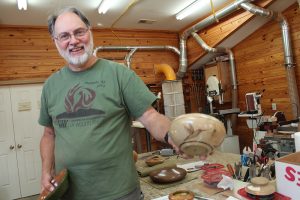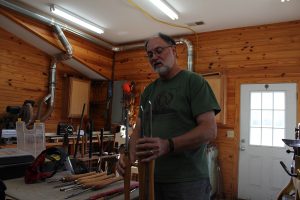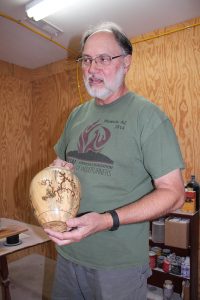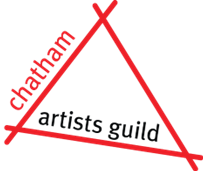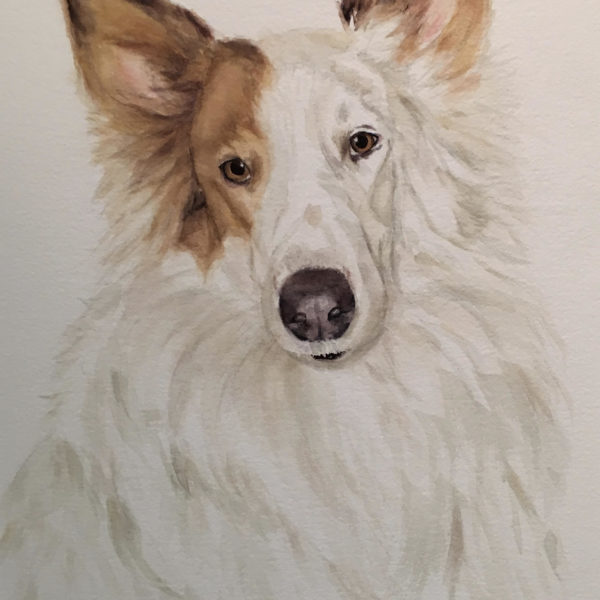Michael Thompson
2460 Pete Thomas Road
Pittsboro, NC 27312
Interview by Zoe Allison
Updated November, 2020
Z – How did you get into your woodturning?
M – I have a degree in forestry. My career focused on teaching people how to recognize what is in their forest and how to better manage it. I spent 31 years in my forestry career here in NC. When I retired in 2003 I was planning on working primarily building furniture. A friend asked if I would be willing to make him some stools so he could weave bottoms in them. I took classes on woodturning and became hooked. I made the natural transition from managing forests to working with wood grown in them.
Z – What sets your products/business apart from the rest? Why should customers come to you?
M – One thing is attention to detail. I want create pieces that are pleasing to the eye and to the touch. I like for my pieces to have flowing curves. Another is much of my wood comes from local sources, trees removed from around houses or un-useable logs from forestry operations. I try to keep track of where each piece of wood comes from so I can pass that along to the customer. Many customers like to make that connection.
Z – What are some challenges of your medium? Or particulars about your process?
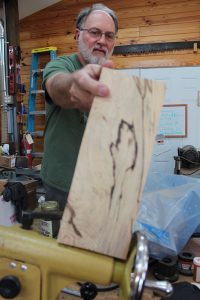
M – One major challenge is figuring out how to safely hold the wood on the lathe so I can create the piece that I have envisioned.
I work with a lot of green (wet) wood. It is turned to general form that I want and left at least 1” thick. It is then placed in a paper bag or cardboard box, packed with the wet shavings and allowed to dry for at least 6 months. It is then placed back on the lathe and turned into its final shape, sanded and finish is applied.
Z – How much do your products cost and how do you price them?
M – Pricing is based on time spent making the piece, the size, the wood species and what other treatments did I do on the piece.
My pieces vary by piece and type of item made. I think you will find them very reasonable.
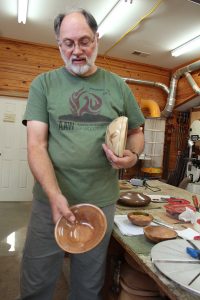
Z – Where can people view and possibly purchase you work?
M – At my studio during the Chatham Artists Studio Tour and at other times by appointment. They can also be found at locations in Chapel Hill, Pittsboro and Southern Pines.
Z – What distinguishes your pieces?
M – One thing I believe adds value is that I have been numbering my pieces since I began turning. I sign them and put the species on the bottom of the piece with the number.
Z – What inspires your turning?
M – My inspiration comes from the piece of wood and what I see in the wood. The color, the wood grain and the natural imperfections in the wood. Other inspiration comes from natural world and trying to capture that and incorporate that in the turning.
Z – Can you describe the wood piece in the brochure?
M – The piece is made out of a hollow tree. My vision was to turn a globe and hollow it. During the process, the natural beauty of the inside of the hollow log caught my eye so much that I left the weathered surface as is to provide contrast with the outside turned surface. A stand was created to hold the form so light would shine through the piece.
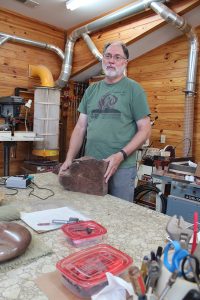
Z – Do you have a philosophy that you bring to your work?
M – Each person is a product of everything they have ever done, every relationship, their life’s experiences. Each of us is truly a unique combination. This philosophy goes into my vision for my work.
Z – Is there any particular group that influences your work?
M – I’m more influenced by local artists because of personal interactions with them and the Studio Tour provides an opportunity to see other artists work in various shows. You develop ideas of how I can use a technique I’ve seen on my turnings. How can I combine fiber with a turning? How could I incorporate glass into a piece or stone? The possibilities are endless.
Z – Can you describe an unusual piece that you have done lately?
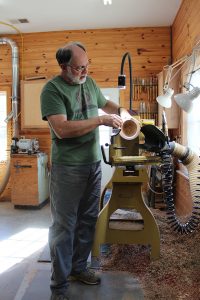
M – I did a silver wire inlay on a piece and another using copper wire. It was an interesting process. I still want to do more using wire. There’s a lot of open road to explore and experiment with. I am inspired and positive. Now I just have to find the right piece of wood.
Z – How do you feel about the upcoming tour?
M – I am optimistic.
Over the last few years other artists near me have dropped off the Studio Tour. My challenge is to bring people to the outer edge of the other artists on the Tour. I try to include new species of wood each year and add a form that I haven’t done before. I have lots of new work to show and I’m hoping for good attendance.
